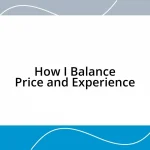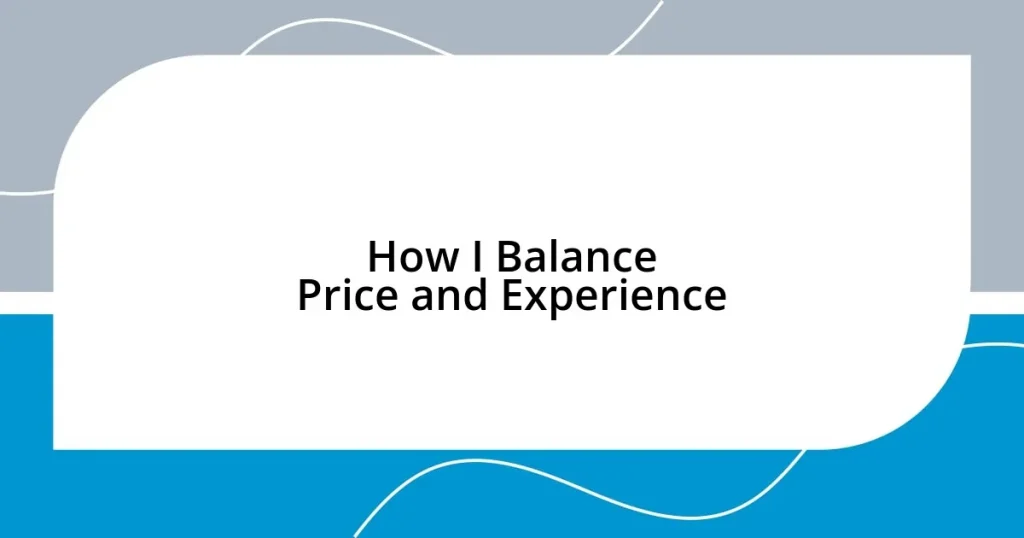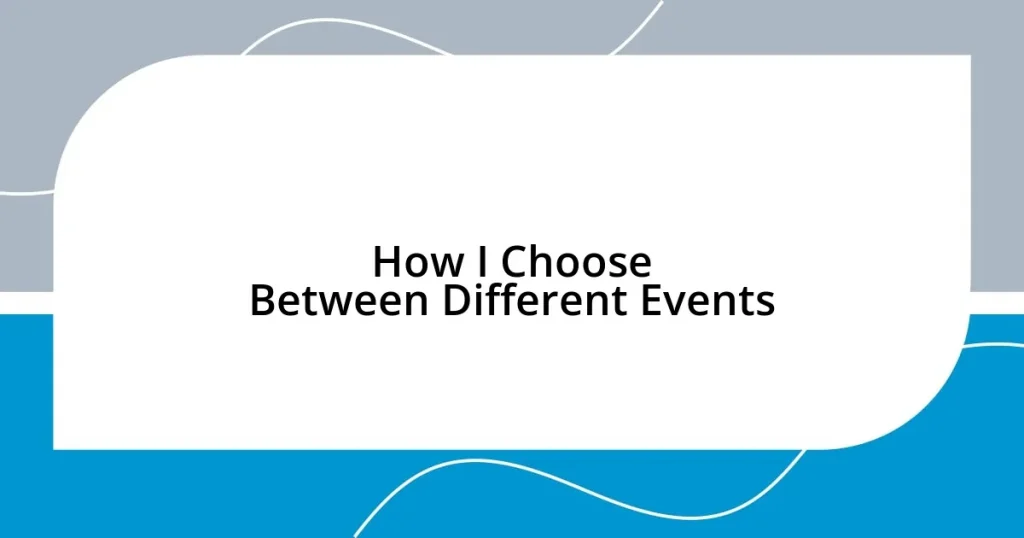Key takeaways:
- Higher prices can enhance experience, but low-cost options can also surprise with quality; value isn’t solely determined by price.
- Understanding customer expectations is crucial, influenced by perceived value, brand reputation, previous experiences, and marketing.
- Effective price management strategies, like dynamic pricing and tiered options, cater to diverse customer preferences and enhance perceived value.
- Continuous feedback and engagement with customers lead to improved offerings and foster loyalty, demonstrating responsiveness as key to satisfaction.
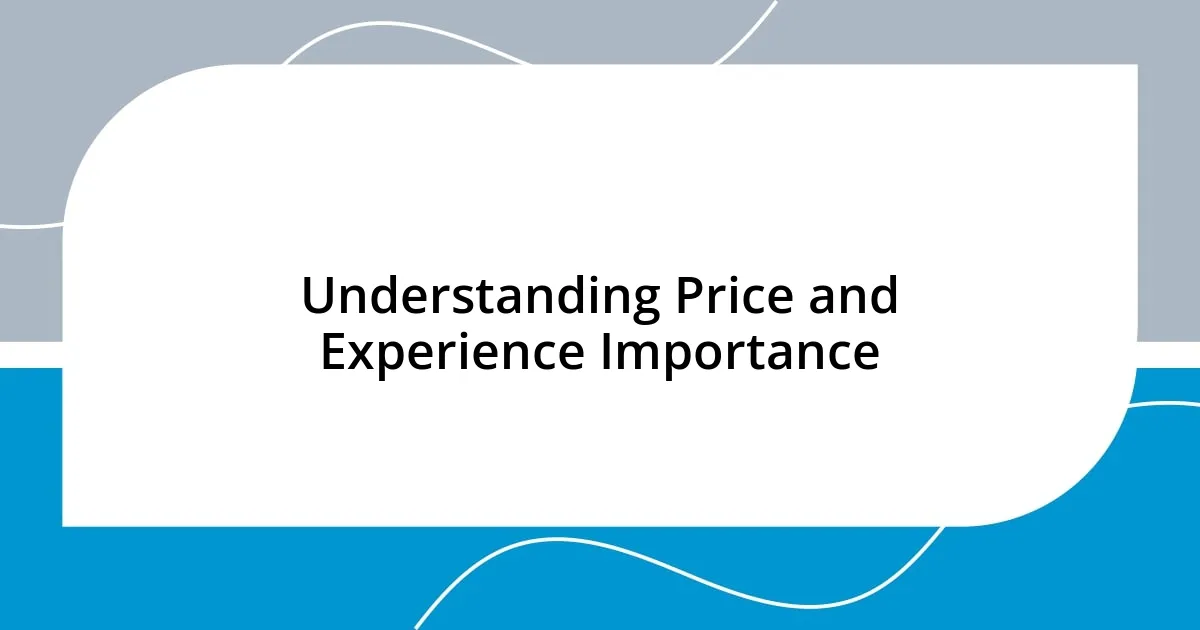
Understanding Price and Experience Importance
When it comes to balancing price and experience, I often reflect on my own purchasing decisions. For instance, I once splurged on a high-end kitchen appliance simply because I valued the brand’s reputation for quality and long-lasting performance. I realized then that while I could have saved money, the satisfaction and functionality it brought into my daily cooking were worth every penny.
It’s fascinating how we sometimes equate a higher price with a better experience. Have you ever wondered why some of your most memorable moments come from experiences you intentionally invested in? I think back to that time I chose a more expensive hotel during a vacation, which ultimately led to exceptional service and an unforgettable stay. It’s in moments like these that I recognize the profound impact of price on the overall experience.
Conversely, I’ve been surprised by how low-cost options can sometimes deliver unexpectedly great experiences. I remember grabbing a meal from a local food truck, thinking it would be a quick bite, only to find it bursting with flavors that rivaled gourmet restaurants. This taught me that while price can be an indicator of quality, it doesn’t always dictate the richness of the experience we might encounter.

Analyzing Customer Expectations
Understanding customer expectations is crucial for anyone trying to balance price and experience. I remember the anticipation I felt when ordering an expensive pair of shoes online, convinced that their price would guarantee both comfort and style. However, when they arrived, they fell short. The disappointment taught me how important it is to manage expectations—sometimes, the price doesn’t correlate with the experience we hope for.
When analyzing customer expectations, several factors come into play:
- Perceived Value: Customers often associate higher prices with superior quality.
- Brand Reputation: A well-established brand can set higher expectations due to its history.
- Previous Experiences: If customers had a great experience in the past, they expect that same level of quality.
- Peer Recommendations: Positive feedback from friends or family can raise expectations significantly.
- Marketing Influence: Promotional tactics can heighten aspirations, affecting perceived experience.
Reflecting on these elements helps to clarify what customers seek and how to align offerings with those expectations.
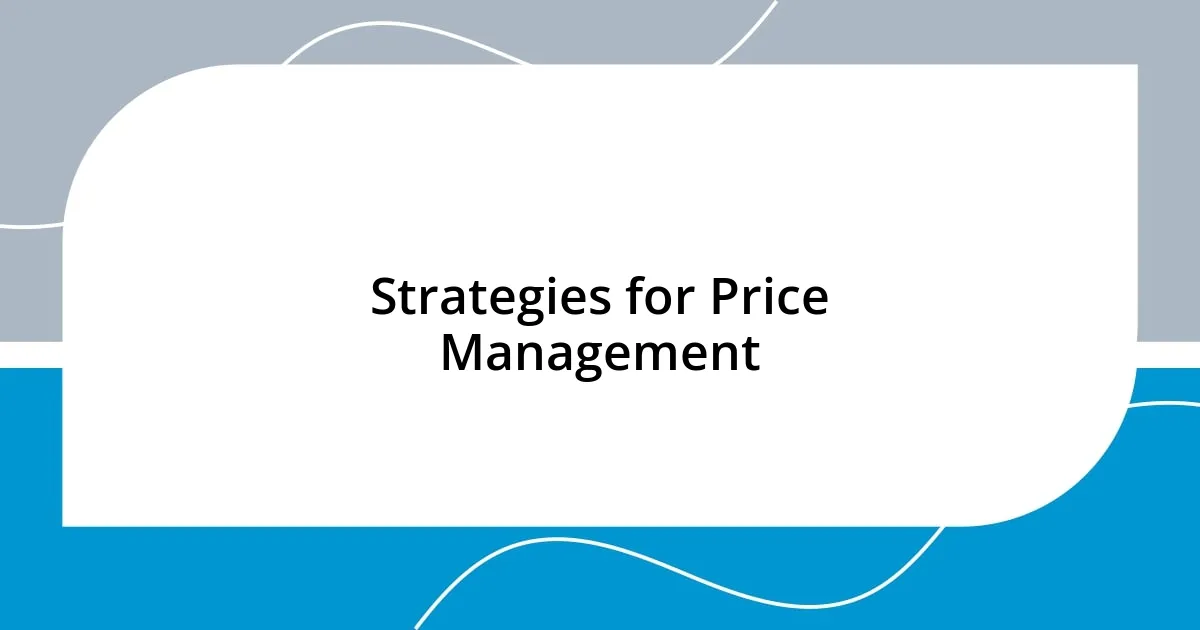
Strategies for Price Management
When it comes to price management, I find that dynamic pricing can be a powerful strategy. For example, during a recent trip, I used a travel app that adjusted hotel prices based on demand and availability. I was initially skeptical, but I ended up scoring a fantastic rate for a premium room right before my stay, which was an eye-opening experience in how flexible pricing can enhance value.
Another tactic I’ve adopted is offering tiered pricing. This approach allows customers like myself to choose the level of service or product that fits their budget while still providing varying experiences. Last month, I opted for a mid-tier subscription service that provided excellent content without the luxury of a top-shelf option. It met my needs perfectly, emphasizing how strategic price levels can cater to diverse customer preferences.
Finally, implementing psychological pricing can influence purchasing decisions. I recall when I was deciding between two similar products, one priced at $19.99 and the other at $20. The first option felt significantly cheaper, despite being only a cent less. This simple technique demonstrated how pricing can impact my perception of value and experience.
| Pricing Strategies | Examples |
|---|---|
| Dynamic Pricing | Travel apps adjusting prices based on demand |
| Tiered Pricing | Subscriptions offering various service levels |
| Psychological Pricing | Using $.99 endings to create perceived value |
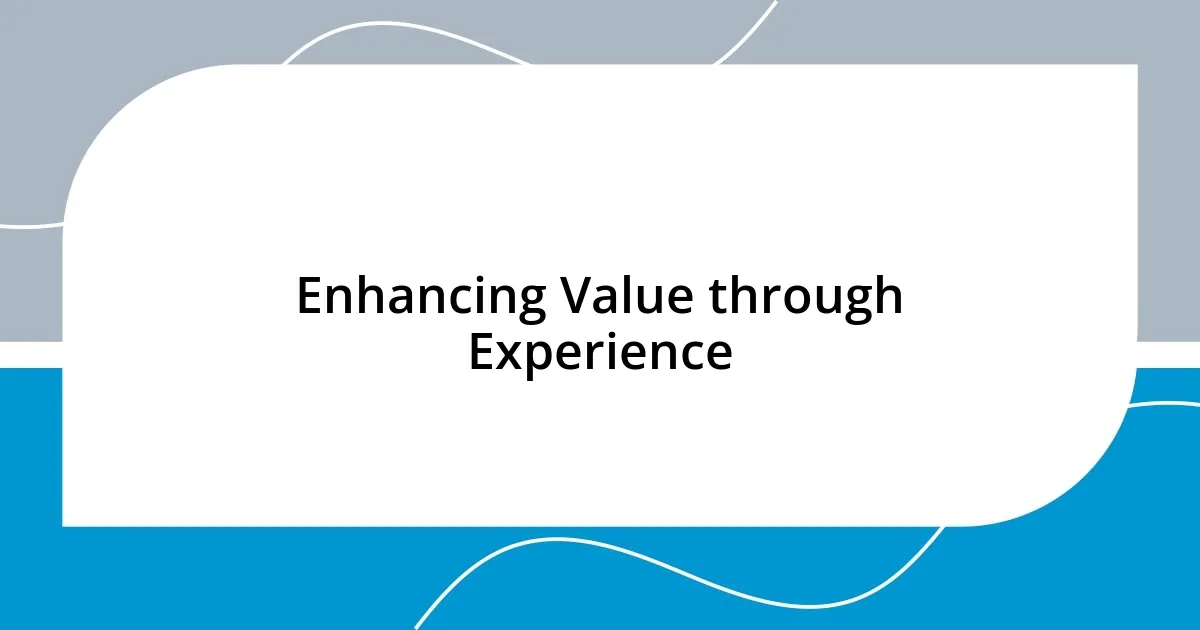
Enhancing Value through Experience
When I think about enhancing value through experience, I’m reminded of a time I attended a workshop that was priced higher than similar events. Initially, I was hesitant—was the extra cost worth it? Once I experienced the engaging presentations and personalized feedback, I knew I made the right choice. The quality of the interactions and the depth of the material far exceeded anything I had encountered before, illustrating how value is often tied to the experience itself, not just the price tag.
Another instance that stands out to me is when I tried a new restaurant that boasted a premium menu. As I entered, the ambiance struck me instantly—it felt luxurious yet inviting. My dinner was much more than just a meal; the staff anticipated my needs and created a warm, welcoming environment. In my opinion, the experience justifies the higher prices. This taught me that sometimes it’s the thoughtful, experiential layers that transform a transactional relationship into a memorable one, making the cost feel less burdensome.
I often wonder how companies can consistently deliver such elevating experiences for their customers. One answer lies in genuinely understanding what customers value versus what they pay. Recently, I participated in an online training course where the instructor didn’t just provide information but created an interactive community. I found myself more engaged than ever, and the higher fees felt justified. It’s clear to me that investing in enhancing the experience can cultivate loyalty and satisfaction—something that all businesses should strive for.
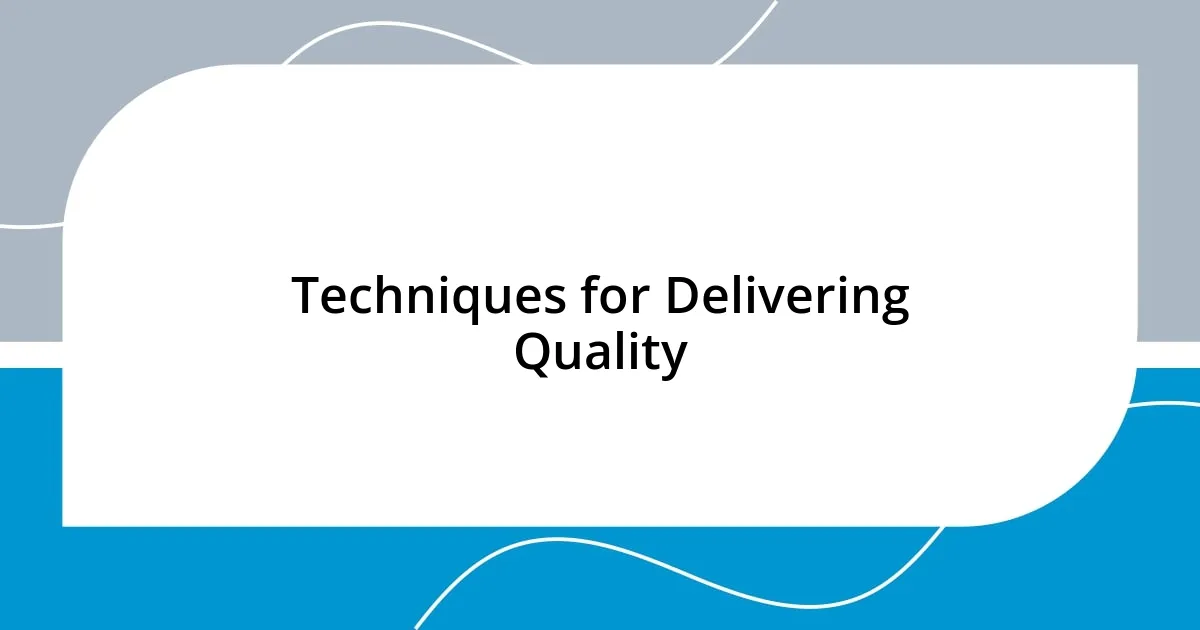
Techniques for Delivering Quality
One technique I find particularly effective for delivering quality is gathering feedback and continuously refining offerings. I once tried out a local gym that regularly sought input from its members on classes and facilities. After sharing my thoughts about the types of workouts I preferred, I noticed they adjusted their schedule to include more high-intensity options. This not only improved my experience but also showed me firsthand how being responsive to customers can significantly elevate the value they perceive.
Moreover, training and empowering staff is essential. I had a memorable interaction at a boutique hotel where the front desk staff genuinely cared about my stay. They weren’t just following a script; they shared personal recommendations and engaged with me about my plans. This sense of personalization transformed my experience. I believe investing time in staff development fosters a culture of excellence, which can lead to amazing guest interactions that justify higher prices.
Utilizing technology to enhance the customer experience is another vital technique. For instance, during a recent online shopping spree, I encountered a retailer that used augmented reality to let me visualize furniture in my space before purchasing. The excitement I felt while “placing” an item in my home made me more confident in spending a bit more. I sometimes ponder how many businesses overlook the power of technology to create truly immersive buying experiences. Embracing digital tools can not only streamline purchases but also significantly boost customer satisfaction.
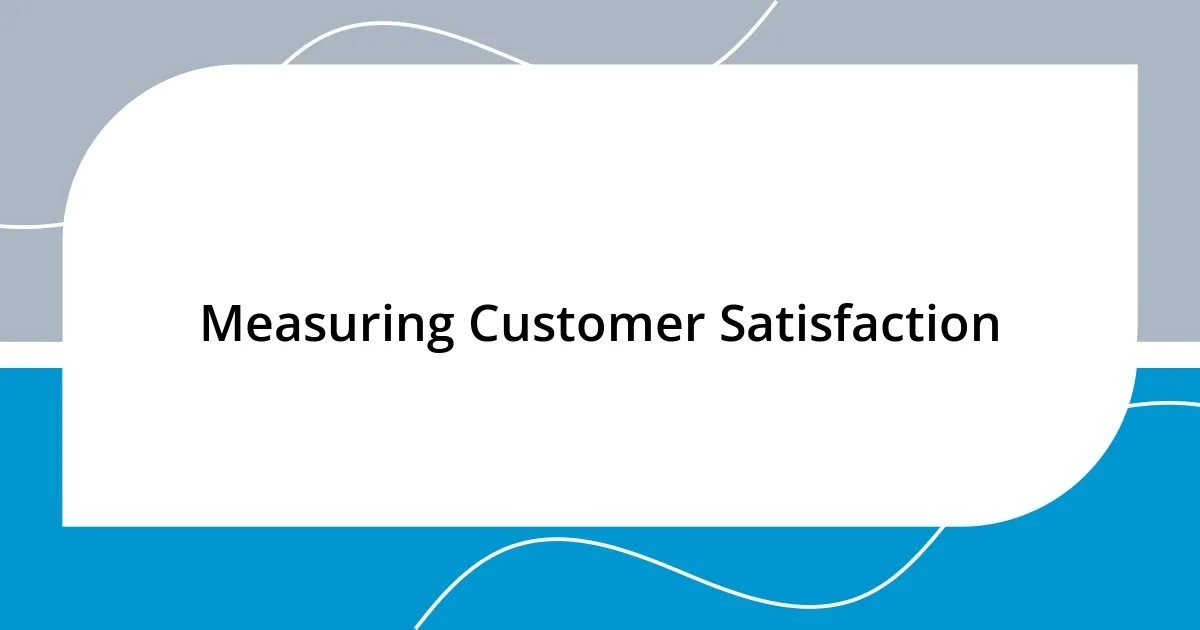
Measuring Customer Satisfaction
Measuring customer satisfaction is a vital part of understanding how well we’re meeting expectations. I remember a time when I completed a customer satisfaction survey after a stay at a hotel. The survey included open-ended questions that allowed me to share my thoughts on everything from the cleanliness of the room to the friendliness of the staff. I realized that businesses genuinely want to improve, and this feedback loop creates a stronger service experience.
In my experience, engaging customers directly can provide insights that numbers alone cannot capture. I once joined a focus group for a product I loved, and it was fascinating to see how passionate people were about the little details. Listening to their stories made the brand understand what truly resonates, reinforcing the idea that satisfaction goes beyond simple metrics. It’s about those unique moments that make us feel valued and understood.
On a broader scale, I’ve seen companies leverage online reviews and social media feedback as part of their satisfaction measurement toolkit. When I browse reviews, I often find that people share not just their opinions but their emotional journeys with the brand. For example, I felt a sense of connection to a company that responded promptly to a negative review, turning a dissatisfied experience into a loyal one. Seeing this level of responsiveness makes me wonder: how many brands miss the opportunity to transform comments into valuable insights for improvement?
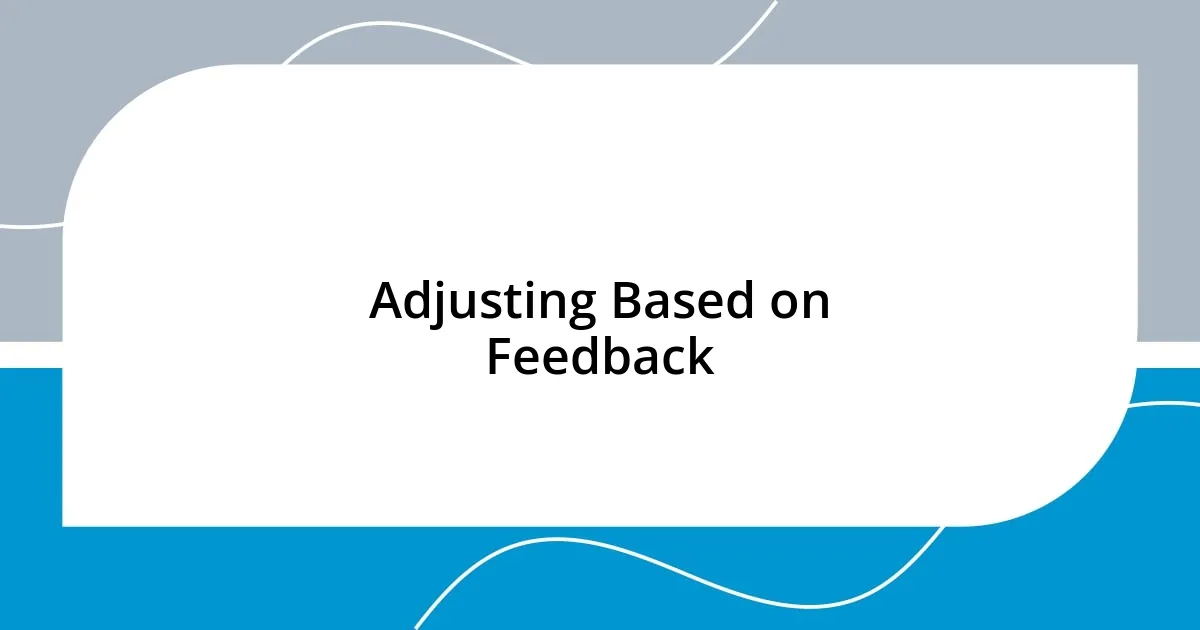
Adjusting Based on Feedback
Adjusting based on feedback is not just about responding to suggestions; it’s about actively listening and evolving. I remember attending a workshop where participants could share their experiences about a product. The organizer took notes and asked follow-up questions, showing genuine interest. This approach not only made us feel valued but also led the team to refine their products in real time, demonstrating that feedback can drive innovation.
I often think about a local coffee shop where I initially had a lukewarm experience. After leaving a constructive review, the owner personally reached out to me. They explained how they intended to change their brew methods based on feedback and even invited me back to try a new blend. This quick adaptation spoke volumes about their commitment to customer satisfaction and fostered loyalty. Have you ever gotten constructive feedback from a place and noticed a tangible change afterward? It truly highlights the power of listening.
Another instance that sticks with me occurred at a restaurant that started a monthly feedback dinner. Diners were encouraged to share their thoughts on the menu directly with the chef. I joined once, and it felt so rewarding to see how my comments on the spice levels were incorporated into the dishes the very next month. The experience reinforced my belief that feedback isn’t just data; it’s a dialogue that can drastically enhance the buying experience. If only more businesses embraced this approach, I wonder how much more impactful their offerings could be.


